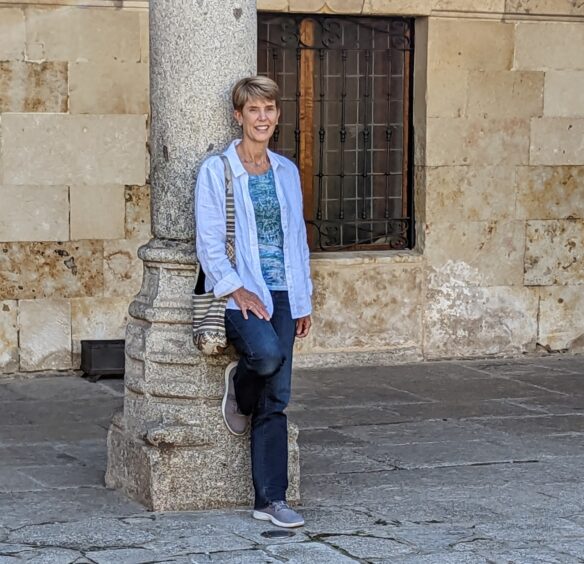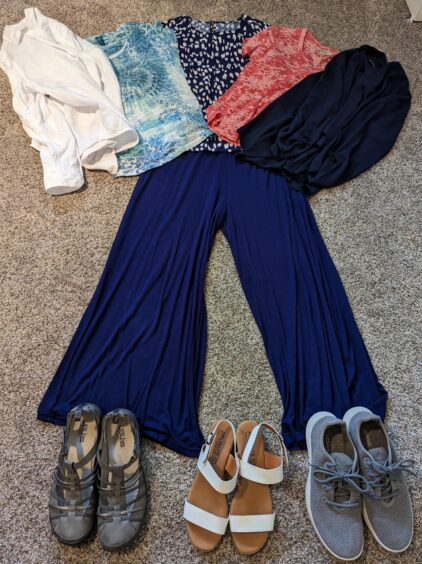
I’ll start by saying that there is no dress code in Morocco or India, and I saw a wide range of clothing choices among tourists. This is an opinion piece—it’s my opinion about how I choose to dress in conservative countries, and I wouldn’t presume to tell others how to dress. I am sharing it because questions in travel groups often come up about how to dress in Morocco, India and other places in the Middle East and beyond. This is one person’s strategy for how to dress in Morocco and India and other conservative countries.

I’m a committed carry-on-only packer, so I favor a capsule wardrobe where pieces mix and match. I do sink laundry, so much of my travel clothing is lightweight and quick-dry.

My experience growing up as an American girl in an expat family informs my clothing choices. We moved from California to Pakistan, a Muslim country, when I was four and I swung between a few years overseas and a year or two in California until I was in my early 20s. Besides Pakistan, I lived in Bangladesh, Peru, and Indonesia. Since then, I have continued traveling all over the world. Times have changed and I’m more relaxed about clothing, but I still feel more comfortable covering up more in conservative countries than I do at home out of respect and convention (my family’s convention).
My guiding principle in conservative countries is to keep shoulders and legs covered. It’s that simple.
For me, this basic guideline translates to:

It varies a bit by country and activities. In some countries and in some houses of worship, it may be appropriate to cover the head or whole body. In some mosques and temples, they may rent full length robes.

Beach and pool locations are often more relaxed, and it may be acceptable to wear shorts or sun dresses at times.

I observe how local women are dressed. I don’t always dress as conservatively as they do, but it informs my choices. I then look at how tourists are dressed and see how much attention they draw. If groups of men stare or gawk or make catcalls, I’m going to cover more skin because I don’t want that kind of attention.

When visiting Aceh, a very conservative community in Sumatra, I identified a few women who looked like they could be Indonesian businesswomen who boarded the plane with bare heads. When we landed in Aceh, I watched to see if they covered their heads, and if they did, I planned to pull out my scarf. Because they didn’t, I left my head bare, but I was ready if I needed it.
See my free downloadable packing lists: https://ingasadventures.com/download/

In cold weather, everyone is covered. The harder decisions are about how to stay cool in searing deserts and tropical jungles, where temperatures can climb above 100F, and humidity can make it feel like a sauna. I usually choose loose, comfortable clothing. Natural fibers are a plus, but I also have quick-dry synthetic fabrics that don’t wrinkle and feel cool.

The conservative countries where I’ve lived and visited are mostly in the Global South and tend to be in equatorial latitudes, which often translates to hot and humid.
See my article on Packing Light for a Trip to India for more tips.
T-shirts, variety of solid colors and patterns, short sleeve (4)
Women’s underwear (3, Jockey-No Panty Line Promise-Tactel)








Disclaimer: Amazon Affiliate links may be used, and Kuhl Trekr pants were provided free in exchange for an honest review. Opinions expressed are my own.
Andrew Paisley says:
I’m not a women but I do agree that dressing like locals especially when one is in country for a long time (a month or more) can be a polite way of honoring the culture one is in. I live in an international neighborhood in Akron Ohio (yes Akron) where we have people from at least 22 different language and people groups who have taken up residence here. It is interesting to me that many (but not all) do not dress “American ”. That’s just an observation not a judgement. I would not expect a conservative Muslim Uzbek women to adopt tight revealing leggings but I might expect the men to dress in jeans and a t-shirt rather than their traditional long top and pants. Anyway just an observation.
Inga Aksamit 2 says:
Thank you for responding. I think with more time, more foreign-born people might adopt western clothing, but it might take another generation. As a person who grew up in an expat family, I can tell you that we covered up more but never adopted saris or kebayas or shalwar kameez when we lived in other countries. We covered our skin so as not to offend, but didn’t feel comfortable adopting clothing that wasn’t from our culture. It’s a part of our identity, I suppose, and I would have felt like I was wearing a costume. I appreciate your observations and respect for other cultures.
Susan Alcorn says:
It is so impressive how wisely (and respectfully) you pack and dress for different countries and situations. I haven’t traveled in Asia, so have not had to think too much about all this. Though you always dress more fashionably than I do, I also consider the differences I might find in the more traditional or conservative settings (mainly cathedrals and small villages) I might find in Europe and Latin America and dress accordingly. The one item that you mentioned that I had not considered was that you don’t wear dresses; I assume because that would be showing legs. I don’t wear dresses when I travel either, but only because I have very few remaining and because they can’t be mixed and matched. IMO, your list and your reasoning are very important info for travelers to know. Thank you!
Inga Aksamit 2 says:
Thanks so much. I don’t pack dresses much because I prefer a top and skirt so I can easily wash different mix and match tops. Washing a dress in the sink gets pretty cumbersome, especially for longer dresses.